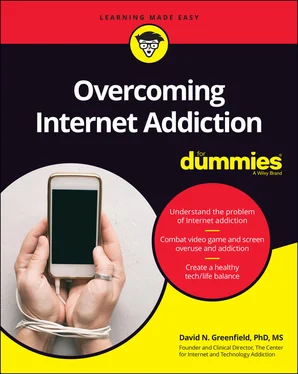 All digital devices have the power to rob you of your time and attention, and this imbalance creates problems.
All digital devices have the power to rob you of your time and attention, and this imbalance creates problems.
The power of, and attraction to, the Internet comes from its ability to connect people with other people, information, and services. This has essentially changed the way we live our lives; however, the most powerful aspect of the Internet is its addictive potential. The way the Internet works can lead to increases in the amount of time you spend online, irrespective of the specific content you consume.
 The Internet is neither good nor bad — it’s amoral. It has no feelings in its power to captivate you. However, you should always keep in mind that the only goal of everything online is to capture and hold your attention. It’s not necessarily a nefarious intention, but nevertheless, it’s a potent force whose purpose is to keep you screen-bound (for largely economic reasons). The only way out of the black hole of the Internet is to take back control of your time and attention.
The Internet is neither good nor bad — it’s amoral. It has no feelings in its power to captivate you. However, you should always keep in mind that the only goal of everything online is to capture and hold your attention. It’s not necessarily a nefarious intention, but nevertheless, it’s a potent force whose purpose is to keep you screen-bound (for largely economic reasons). The only way out of the black hole of the Internet is to take back control of your time and attention.
 Smartphones are the world’s smallest slot machines . Their ease of access and availability make them highly addictive Internet access portals. And making smartphones even more addictive are the notifications they provide you. Each time you receive a notification of some type, your brain registers a triggering signal that a desirable message, information, or content is waiting for you. This facilitates your continually picking up and checking your phone all day long. There are estimates that many of you pick up your phone a hundred times or more a day! The activation of possibly finding something pleasurable when you’re checking is even more rewarding than the content itself. Nothing is more intoxicating than maybe.
Smartphones are the world’s smallest slot machines . Their ease of access and availability make them highly addictive Internet access portals. And making smartphones even more addictive are the notifications they provide you. Each time you receive a notification of some type, your brain registers a triggering signal that a desirable message, information, or content is waiting for you. This facilitates your continually picking up and checking your phone all day long. There are estimates that many of you pick up your phone a hundred times or more a day! The activation of possibly finding something pleasurable when you’re checking is even more rewarding than the content itself. Nothing is more intoxicating than maybe.
See Chapter 4for more information on the addictiveness of smartphones and the Internet.
How do you know whether your digital device has become your digital vice? This isn’t an easy question to answer, as everyone has their own personal values about time and everyone is different in terms of how much disruption is tolerable in their lives. Your technology use is often in part determined by your values around how you use your time and the consciousness you bring to your Internet screen use.
The idea that your screen use typically occurs below your conscious radar is well established. Time distortion and dissociation are common when you are on your screen, so it’s very likely that you don’t actually know how much time passes when you’re staring at your Instagram or Facebook account, or circling down the rabbit hole on Reddit, or caught in an endless YouTube playlist or Netflix binge.
The first step in recognizing your Internet use is to become conscious of how much content you’re consuming, and to become aware of exactly how much time you have unknowingly surrendered to your device. This is perhaps easier said than done, in that most of the time on your device may be spent without a thought, with little awareness that you have begun a slow descent into the electronic sinkhole of the Internet.
The following sections briefly cover addictive platforms and technologies. Part 2is devoted to these topics.
What exactly is social media? I explain in Chapter 5that social media is a broad category of applications and websites that are structured around the idea of connecting people, organizations, or businesses around themes, content, or interest areas. Although there are several well-known social media sites, the definition of social media has also expanded to include newer apps and websites that attract users’ time and attention. Some examples of social media sites are Facebook, Instagram, LinkedIn, TikTok, Reddit, Snapchat, Vine, Twitter, and YouTube, and even travel sites like Waze and Yelp have a social media component; undoubtedly, countless social applications are integrated into other apps and websites, as businesses have found that social sells.
Some social sites are integrated around news and communication, others focus on video and text, and still others are simply about photos and user life updates, posts, and sharing. Some integrate all of these features. Most are without fees to the user; however, none are free. Most accept advertising, and many sell your user data to others for a variety of purposes.
 Make no mistake: If you think there are no obvious payment of costs connected to social media, then you are the payment! Your eyes and attention form the economic engine that drives social media, and many of these platforms have proven to be both addictive and negatively impactful on a variety of psychological levels.
Make no mistake: If you think there are no obvious payment of costs connected to social media, then you are the payment! Your eyes and attention form the economic engine that drives social media, and many of these platforms have proven to be both addictive and negatively impactful on a variety of psychological levels.
Streaming audio and video
Consuming audio and video content (including music, podcasts, and audiobooks) has become commonplace; in fact, most of what you consume in terms of music, TV, movies, Netflix, Amazon Prime, Hulu, podcasts, YouTube, Kindle, and so on is essentially in streaming format. Even software is streamed or downloaded, and your data is increasingly held in the cloud (on a company’s server) instead of on your devices. Streaming means that information and content is pushed to your device in real time, and you watch, read, or listen to it as it is streamed. Sometimes you can download it onto your device and store it for later use.
 Although no one would argue against the convenience of consuming your digital entertainment in this manner, there are some inherent problems. One major problem is that many of these streaming sites have default settings, called autoplay, for audio or video content to keep going to the next movie, TV show, podcast, or YouTube clip — unless you deliberately turn off that feature. The net effect (no pun intended) is that you can end up watching or listening to a lot more content than you intended to or have time for. The automatic “pushed” nature of the content is equivalent to eating out of a large dish with no ability to measure the portion of food (or digital content ) you are consuming. See Chapter 6for more about streaming content.
Although no one would argue against the convenience of consuming your digital entertainment in this manner, there are some inherent problems. One major problem is that many of these streaming sites have default settings, called autoplay, for audio or video content to keep going to the next movie, TV show, podcast, or YouTube clip — unless you deliberately turn off that feature. The net effect (no pun intended) is that you can end up watching or listening to a lot more content than you intended to or have time for. The automatic “pushed” nature of the content is equivalent to eating out of a large dish with no ability to measure the portion of food (or digital content ) you are consuming. See Chapter 6for more about streaming content.
Video gaming is perhaps the most common reason why people seek treatment in our clinic and residential treatment center. Of all the content areas that are consumed on the Internet, video gaming is perhaps the most problematic that we see in terms of negative life consequences. That doesn’t mean that video gaming is bad or inherently dangerous; in fact, most people who use video games have no significant problem with them and are able to use games with little or no negative life impact. In other words, they can use them in a moderated manner. However, there is a small percentage of users (studies suggest between 1 and 10 percent) who cannot self-regulate their use and who spend inordinate amounts of time on gaming platforms, including handheld devices, consoles, and PC-based systems. Most of the patients we treat seem to be having problems with PC-based or console games.
Читать дальше

 All digital devices have the power to rob you of your time and attention, and this imbalance creates problems.
All digital devices have the power to rob you of your time and attention, and this imbalance creates problems. The Internet is neither good nor bad — it’s amoral. It has no feelings in its power to captivate you. However, you should always keep in mind that the only goal of everything online is to capture and hold your attention. It’s not necessarily a nefarious intention, but nevertheless, it’s a potent force whose purpose is to keep you screen-bound (for largely economic reasons). The only way out of the black hole of the Internet is to take back control of your time and attention.
The Internet is neither good nor bad — it’s amoral. It has no feelings in its power to captivate you. However, you should always keep in mind that the only goal of everything online is to capture and hold your attention. It’s not necessarily a nefarious intention, but nevertheless, it’s a potent force whose purpose is to keep you screen-bound (for largely economic reasons). The only way out of the black hole of the Internet is to take back control of your time and attention.










